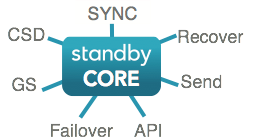Dbvisit Standby Version 8.0.x - New Features
These 4 components work together to provide a full solution that can help you manage your Oracle Standard Edition (SE1, SE and SE2) standby database environment.
In summary, these components perform the following tasks:
| Component | Icon | Description |
|---|---|---|
Dbvserver |
| |
Dbvagent |
| |
Standby Core |
| |
Dbvnet |
|
The diagram below provides a brief overview of how the above four components work together. The DBA (Administrator) will have the option to either run commands via the Command Line Interface (Standby Core) using the dbvctl utility - or - They can make use of the new Central Console which can be used to manage multiple installations.
Note: The above diagram is just a high-level representation of how Dbvisit Standby v8 components communicate.
2. New Features
Dbvisit Standby version 8 new features are listed below in no particular order:
- The command line interface is now consolidated into one single easy to use executable - "dbvctl"
- The Dbvisit Standby Core repository is no longer stored in the Oracle Database
- The repository has now been moved outside the Oracle database and is located in DBVISIT_BASE/standby/conf directory
- The repository name is DB_NAME.db
- The directory structure of version 8 is similar to version 7 with the addition of the new Dbvisit Agent subdirectory
- Dbvserver has been totally rewritten and now have a smaller footprint and is hosting a brand new web-based user interface - referred to as the "Central Console"
- The new Central Console:
- Can manage multiple Dbvisit Standby v8 installations
- The new web interface has a new easy to use modern look and feel
- A small repository is used on the web server to keep track of task information
- Can handle multiple users (each DBA in the team can have their own login)
- All core functions can be performed via the Central Console
- Dbvisit Standby agent must be installed and running on all database servers
- Dbvnet has been totally rewritten with improved performance, stability and footprint
- Improved Batch Operations:
- Installation
- Create Standby Database (CSD)
- Synchronize Standby Database (SYNC)
- Creation of Standby Database Templates
- Graceful Switchover (GS) Improvements:
- Execute / Start GS now from only one node
- No additional keys or execution of commands on the remote server required
- Improved output
- Various performance improvements - especially in environments with large redo logs and slow networks
- The GS process will now keep track of all trace files generated
- Auto rollback has been implemented (if possible)
- Improved Archivelog Management Module (AMM)
- Various improvements for Windows-based installations
- Improved handling of Oracle Database 12c SE/SE1 and SE2 installations
- Support for Oracle Database 12c SE/SE1 and SE2 Multitenant (Single PDB)
- New Improved and Exposed Command Line API
- New Dbvisit Agent (dbvagent) is introduced.
- This new component will allow for communication between the Central Console and the Standby Core.
- All communication between the Central Console and Dbvisit Agent is encrypted
- Tasks from the Central Console are executed on the Standby Core and task updates are pushed to the Central Console
- New Support Package option is introduced
- To allow for faster and easier support we have introduced a new "Support Package" option.
- If an error is received the Process ID will be displayed, the user can then create a support package
- This support package will include all required information for the Dbvisit Support team to allow for quick and easy investigation of errors
- The support package can be created from the command line as well as via the Central Console - from where it can even download the support package
- Basic support for cascading standby databases have been introduced in Dbvisit Standby version 8
- Oracle RAC Support Improvements:
- Dbvisit Standby version 8 includes a large number of improvements with regards to managing Oracle RAC standby configurations
- Dbvisit Standby version 8 is now more Oracle RAC aware.
- If you have an Oracle RAC capable standby environment (Clusterware and storage configured with the database software installed), you can now create a full Oracle RAC enabled standby database using the Dbvisit Standby CSD process
- Dbvisit Standby is now executed (running) on only one of the RAC nodes
- Shared Storage is required for the Dbvisit Standby Installation as well as a Virtual IP for the cluster to be used by Dbvisit Standby only
- Improved SQL and RMAN connections to the Database
- Shared connections are used by default
- Improved error handling
- SSH Support for network communication is still supported on UNIX systems. SSH passwordless authentication is required.




